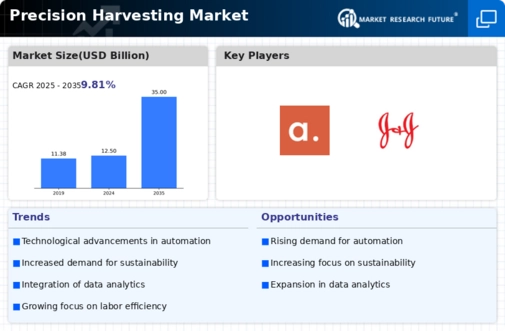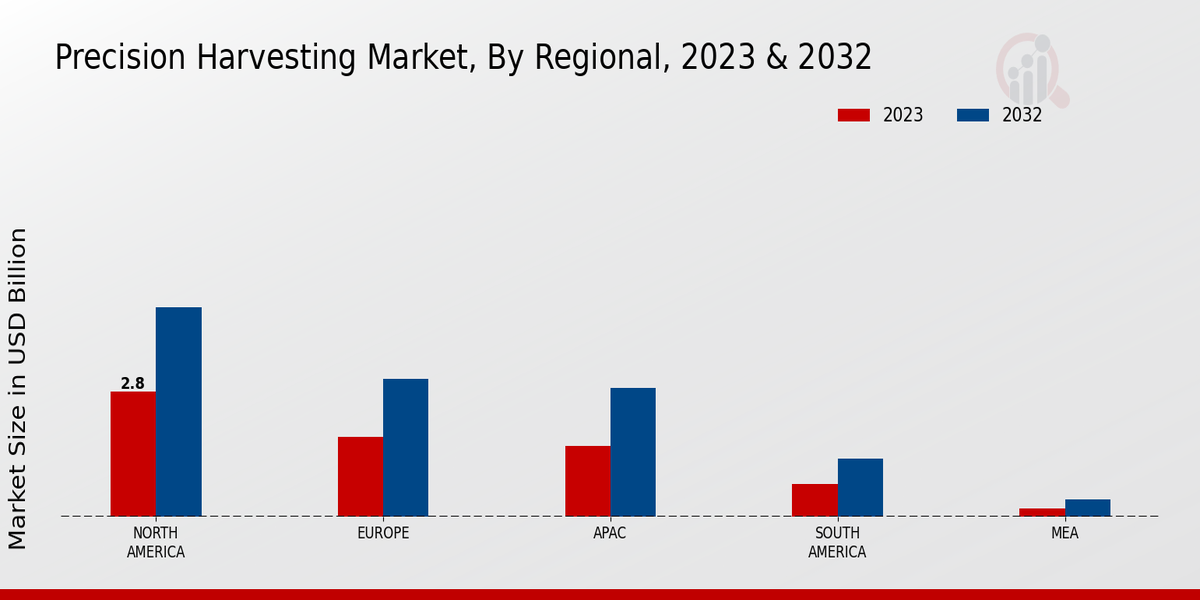Rising Labor Costs
The Global Precision Harvesting Market Industry is significantly influenced by the rising labor costs associated with traditional farming methods. As labor expenses continue to escalate, farmers are increasingly seeking automated solutions to maintain profitability. Precision harvesting technologies, such as robotic harvesters, offer a viable alternative by reducing the reliance on manual labor. This shift not only addresses labor shortages but also enhances operational efficiency. Consequently, the market is expected to grow substantially, with projections indicating a value of 35 USD Billion by 2035. This trend underscores the necessity for farmers to adopt precision harvesting techniques to remain competitive.
Market Growth Projections
The Global Precision Harvesting Market Industry is expected to witness substantial growth in the coming years. Projections indicate that the market will reach a value of 35 USD Billion by 2035, driven by various factors such as technological advancements and increasing demand for food security. The anticipated compound annual growth rate of 9.81% from 2025 to 2035 reflects the industry's potential for expansion. This growth trajectory suggests a robust market environment, encouraging investments and innovations in precision harvesting technologies. Stakeholders are likely to capitalize on these trends to enhance agricultural productivity and sustainability.
Sustainability Initiatives
Sustainability initiatives are becoming a driving force in the Global Precision Harvesting Market Industry. As environmental concerns grow, there is an increasing emphasis on sustainable agricultural practices. Precision harvesting technologies facilitate resource conservation by minimizing chemical usage and optimizing water management. For example, precision irrigation systems enable targeted water application, reducing waste and promoting environmental stewardship. This alignment with sustainability goals is likely to attract investment and support from various stakeholders, further propelling market growth. The anticipated compound annual growth rate of 9.81% from 2025 to 2035 reflects the industry's commitment to sustainable practices.
Technological Advancements
The Global Precision Harvesting Market Industry is experiencing rapid technological advancements that enhance efficiency and productivity. Innovations such as autonomous harvesting machinery and advanced sensors are transforming traditional farming practices. For instance, the integration of GPS technology allows for precise navigation and crop monitoring, reducing waste and improving yield. As a result, the market is projected to reach 12.5 USD Billion in 2024, reflecting a growing demand for these technologies. Furthermore, the adoption of data analytics in agriculture enables farmers to make informed decisions, optimizing resource allocation and ultimately contributing to the market's growth.
Government Support and Policies
Government support and favorable policies play a crucial role in shaping the Global Precision Harvesting Market Industry. Many governments are implementing initiatives to promote the adoption of precision agriculture technologies. These initiatives often include financial incentives, grants, and research funding aimed at enhancing agricultural productivity and sustainability. For instance, various countries are investing in agricultural innovation hubs to foster the development of precision harvesting solutions. Such support not only encourages farmers to adopt new technologies but also stimulates market growth. As a result, the industry is poised for expansion, with significant investments expected in the coming years.
Market Demand for Food Security
The Global Precision Harvesting Market Industry is increasingly driven by the growing demand for food security in the face of a rising global population. As the population is projected to reach approximately 9.7 billion by 2050, the need for efficient agricultural practices becomes paramount. Precision harvesting technologies enable farmers to maximize yields while minimizing resource inputs, addressing the challenges of food production. This demand for enhanced productivity is likely to propel the market forward, with estimates suggesting a market value of 12.5 USD Billion in 2024. The urgency for food security underscores the importance of adopting precision harvesting solutions.




